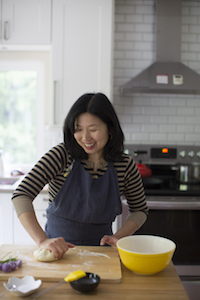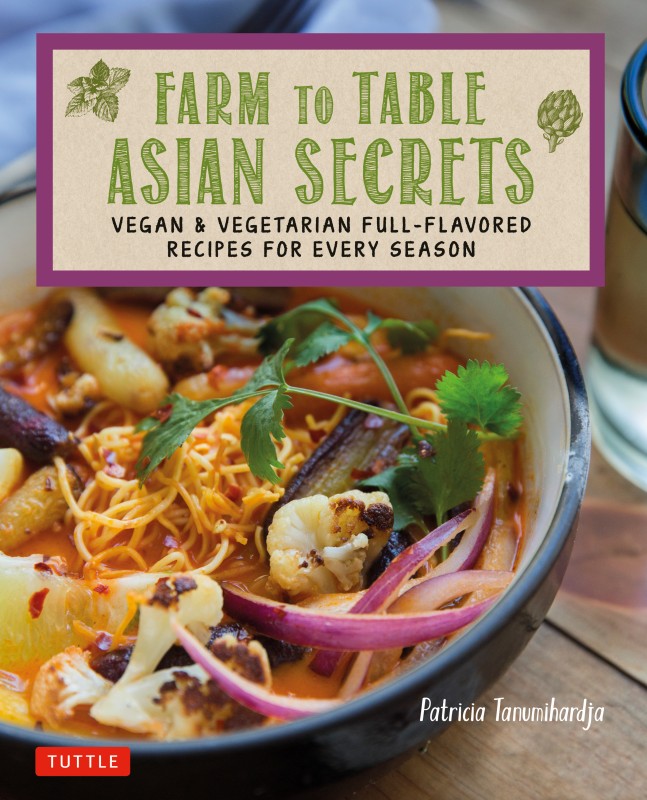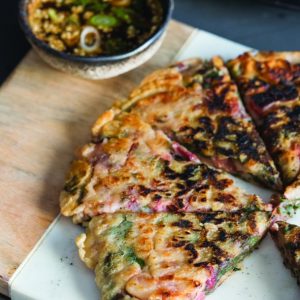MY FAVORITE PEOPLE, MY FAVORITE RECIPES: Pat Tanumihardja

I fell in love with Pat Tanumihardja with the release of her first book, The Asian Grandmothers Cookbook. Born and raised in Indonesia, Pat definitely has the Asia thing down, but never knew her grandmothers. Because of that, she was drawn to traditional Asian cookery, connecting to her cultural roots through food. I’m likewise drawn to traditional recipes — of every cuisine — and have a romantic attachment to ancestors I never knew.
The difference is, I actually want to eat the dishes shared by the surrogate grandmothers Pat met in the writing of her book. The eastern European eats of my great-great-great-great-greats? Not made for Miami and often not vegan-friendly.
Based in the DC area, Pat continues to transmit Asia’s rich cultural and culinary legacy through her blog Pickles and Tea, a collaboration with the Smithsonian’s Asian Pacific American Center and through her new book Farm to Table Asian Secrets — Vegan and Vegetarian Full-Flavored Recipes for Every Season. Traditional yet timeless, these dishes make every season delicious. Pat’s adorable guest post about learning to love winter vegetables made me fall in love with her all over again.

Wrangling with Winter Vegetables
By Pat Tanumihardja
Winter vegetables aren’t easy to love. Even I admit it.
Unlike the rainbow-hued vegetables of spring and summer, winter’s bounty is cloaked in shades of beige, green, darker green and the occasional orange (thank you, carrots and pumpkins!)
As dull and unexciting these vegetables may seem, I’ve realized there is hope yet if you put on your culinary thinking cap.
Think about winter’s freezing temperatures and four-foot snow drifts.
When a 5-year-old spies the snowy landscape outside his window, he thinks:
“Yay, no school!”
“Snowball fight!”
“Let’s go sledding!”
On the other hand …
… dad thinks: “Ugh, I have to shovel the driveway…”
… mom thinks: “What am I going to do with junior for a whole entire day?!”
It’s all about perspective.
By looking at winter vegetables in a different light, meals can take on new meaning, and flavors.
Brussels sprouts evolve from boiled blech to Roasted Brussels Sprouts with Sweet Chili Sauce. Panko breadcrumbs gussy up boring mashed root vegetables into Winter Squash Croquettes.
Any winter green can channel the tropics—think creamy coconut milk and fiery chilies—when tossed into Winter Greens and Tofu in Spicy Coconut Sauce.
Over the years, I’ve learned to embrace (or endure?) the winters, cabbage recipes and snow storms et al. I even have a motto (which I stole from the Norwegians) –There is no such thing as bad weather, just bad clothing.
And when I’m faced with my umpteenth bundle of rainbow chard, I don’t get mired in despair, I get inspired.
Et voilà, the results!

Rainbow Chard Korean Pancake
In this hearty Korean staple, rice flour adds texture for crispy edges while leaving the middle slightly chewy. But even if you omit it, the pancakes will still be tasty. Aim for a consistency that's between crepe batter and American pancake batter. The batter should coat the back of a spoon and drip down in a thick stream. Admittedly, I've never been good at flipping pancakes and omelets, so I sometimes divide up the batter into smaller portions and make smaller pancakes.Ingredients
Rainbow Chard Korean Pancake:
- 1 ¼ cups 150 g all-purpose flour
- ⅓ cup 150 g rice flour
- 1 ½ cups 375 ml water
- 8 oz 250 g rainbow chard
- 5 tablespoons vegetable oil divided
- ½ cup 75 g sliced yellow onion
- Fine sea salt
- Soy and Green Onion Dipping Sauce
Soy and Green Onion Dipping Sauce:
- ¼ cup 60 ml soy sauce
- 2 tablespoons rice vinegar
- 2 tablespoons water
- 1 ½ tablespoons sesame oil
- 1 ½ tablespoons honey
- 2 tablespoons roasted sesame seeds crushed with a mortar and pestle
- 2 teaspoons coarse chili pepper flakes or chili paste
- 2 green onions scallions, green and white parts, chopped
Instructions
Rainbow Chard Korean Pancake:
Soy and Green Onion Dipping Sauce:


Leave a Reply